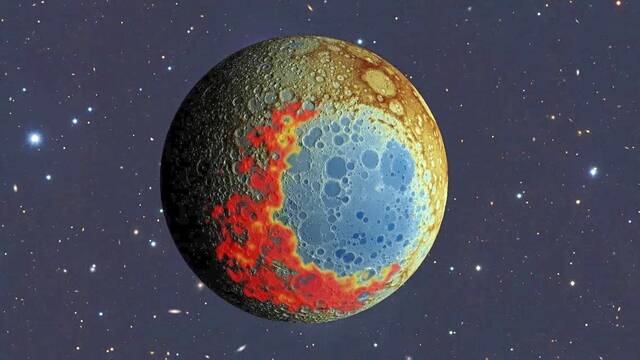Moon's largest crater harbors secret on south pole where NASA astronauts will land
U.S. astronauts who return to the moon’s surface in the years ahead for the first time in more than half a century will have the difficult and unprecedented task of setting the stage for a permanent human lunar settlement.
That may be the primary objective for spacefarers in NASA’s Artemis lunar program, but it won’t be their only one. Indeed, a team of researchers at the University of Arizona says that astronauts who land on the moon’s south pole have a unique opportunity to also collect some lunar samples that could reveal clues about the origins of Earth’s natural satellite.
New research published Oct. 8 in the journal Nature proposes a theory for how the moon’s crater-riddled far side came to be so different from the near side facing Earth. It just so happens, one of these larger impact craters, known as the South Pole-Aitken basin, is located in the region of the moon’s south pole where NASA could land astronauts as early as two years from now.
Here’s what to know about the new research, and how Artemis III astronauts could help retrieve lunar samples for further study here on Earth.
Why does the moon have craters?
The moon’s heavily cratered surface serves as a testament to how Earth’s closest celestial neighbor has become a figurative magnet for space rocks throughout its 4.5 billion-year history.
The impact craters are the depressions or markings left behind after something like an asteroid or comet crashes into the moon’s surface, according to NASA.
Similar craters are visible on other planets in our solar system, but the lunar craters are set apart. That’s not only because the moon’s proximity to Earth makes them easier to study, but because forces like wind and flowing liquid surface water aren’t constantly reshaping the moon’s environment.
For that reason, the craters on the moon are well-preserved time capsules providing evidence of “the process that built and shaped our entire solar system,” NASA says.
Could NASA astronauts collect lunar samples for study on Earth?
One of the best examples of this phenomenon? The moon’s largest impact feature, the South Pole-Aitken Basin.
Spanning more than 1,500 miles in diameter, the basin is the result of a giant asteroid slamming into the far side of the moon about 4.3 billion years ago. Because of its sheer size, the basin is also at the center of the lunar mystery of why its sides look so different from one another.
In the new study, led by Jeffrey Andrews-Hanna, a planetary scientist at the University of Arizona, researchers suggest that the oblong shape of the basin isn’t from a head-on collision with an asteroid coming from the south, as previously believed. Instead, a “glancing blow” from the north created the basin’s signature teardrop shape and unleashed radioactive material — remnants of the moon’s ancient magma ocean — from deep within the moon’s interior, the study found.
Orbiting spacecraft can provide researchers with a basic idea of the moon’s composition. But gathering and studying some of that material could help researchers solve some celestial mysteries about the moon, including why its crust is much thicker on the far side, Andrews-Hanna suggested in a press release announcing the findings.
“With Artemis, we’ll have samples to study here on Earth, and we will know exactly what they are,” Andrews-Hanna said in a statement. “Our study shows that these samples may reveal even more about the early evolution of the moon than had been thought.”
When will astronauts return to the moon? NASA plans Artemis missions
The moon’s south pole is where NASA is planning to land a crew of astronauts as early as 2027.
That mission, known as Artemis III, would be the first U.S. crewed lunar landing since NASA’s historic Apollo campaign came to an end in 1972.
But this time, NASA isn’t looking to simply plant the U.S. flag before having its astronauts head back to Earth. Instead, the plan is for NASA astronauts to help establish a permanent lunar settlement that would be a catalyst in making future human missions from the moon to Mars possible.
The moon’s south pole region, which is largely unexplored except for a few uncrewed robotic missions, is believed to be home to subsurface water ice that could be a valuable resource for astronauts living and working at a lunar base. If water could be extracted, humans could use it for drinking, breathing and as a source of hydrogen and oxygen for rocket fuel.
NASA’s Artemis program began in November 2022 when an uncrewed Orion capsule launched from the Kennedy Space Center in Florida on a moon-orbiting mission to test the vehicle.
Before a lunar landing mission is attempted, NASA is planning to launch four astronauts on its Artemis II mission in 2026 on a 10-day mission circling the moon.
Remove the ads from your TribLIVE reading experience but still support the journalists who create the content with TribLIVE Ad-Free.

